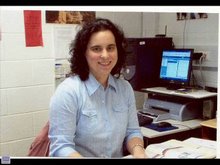
This morning we said goodbye to Istanbul and headed on our bus journey to Bursa. On our way we we visited the
Enka School in
Adapazari. This region suffered a terrible earthquake in 1999 and 20,000 people died as a result. Enka School was set up in aftermath of that earthquake to help the children of the victims. Most of the students who attend this school are orphans. Here are some facts on the visit:

- Supported by multinational corporation, their purpose is to serve children who lost their homes and families
- Private, but free to students (uniform, meals, transport, board)
- Budget is $3.5 million annually
- Began building 40 days after earthquake by searching out needy children and teachers
- Now 560 students, K-12 (ration 8:1)
- Entrance is difficult and according to need (85% poor, disadvantaged)
- Projects displayed in hallways, activity encouraged
- Not interested in aesthetics of building itself (focus on kids)
- Curriculum is student-centered
- Separate elementary and high school
- Covered gym
- IB programs
- Mentoring
- After school activities
- Technology (4,000hrs of instruction)
- Dance, art, music
We were very much moved by the service learning essential of the school. The seniors have to do community service before graduation and the teachers proudly shared one of their projects on helping a poor nearby village improve their school and community center.
We proceeded next to
Iznik, Turkey. In ancient times this city was called
Nicea,
located on the

shore of a peaceful lake. The city first flourished under
greek rule in the 4
th century
BCE. It was here in the 4
th century that the First Ecumenical Council was held and formulated the Nicene Creed-a statement on the basic beliefs of Christianity (I Believe in God....")
While there we visited the
Isnik Foundation, an organization dedicated to reviving the tradition of Turkish tile-

making (
http://www.iznikvakfi,org/). It was fascinating to watch the women move through the age-old process.
Our tour’s final destination for the day was Bursa. Bursa has a special place in the hearts of Turks for it was the first capital of the Ottoman Empire. Bursa has many ancient mosques , medresses, (seminaries) and hamams (bathhouses). It is also was the center of the Silk trade and home to the famous “Turkish Towel.” Our hotel was the Karavanaray Thermal Hotel. This hotel was once offered rest, food and relaxation to tired sojourners and their animals along the Silk Road and is connected to an ancient spring. Before dinner, I enjoyed a luxurious
Turkish Bath experience at the Hotel. It was one of the most memorable and most relaxing and pampering experiences on my trip so far. A must do for any traveler through Turkey.
In the evening we attended a Hacivat and Karagoz traditional Turkish shadow puppet show at the Karagoz House in Bursa. Please see my link on traditional Turkish shadow theatre for more information.






























